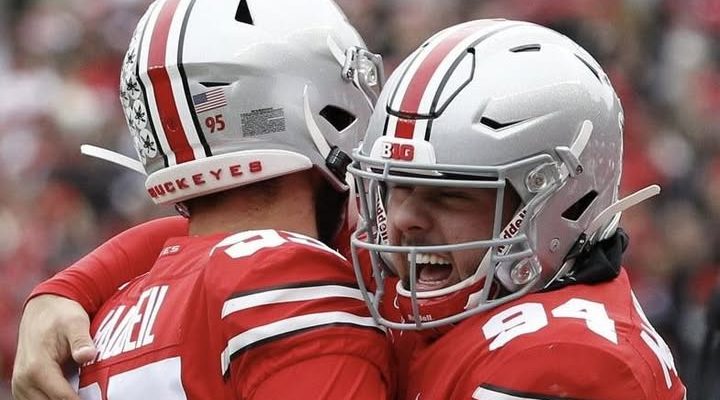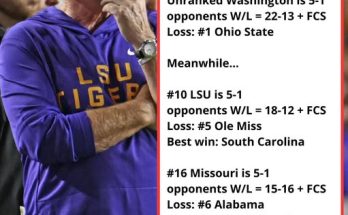The world of college football is often filled with narratives that extend beyond the playing field. While the Ohio State Buckeyes were preparing for one of the most anticipated matchups of the 2025 season against the Texas Longhorns, news broke that a former Ohio State player had been arrested on a serious charge just hours before kickoff. The timing of the arrest sent shockwaves through the Buckeye community, sparking conversations about accountability, legacy, and how moments off the field can intertwine with the emotions of a fan base during monumental games. This incident, while separate from the actual performance on the field, nonetheless cast a shadow that many could not ignore, particularly because Ohio State would go on to secure a massive victory against Texas in primetime, a win that could very well shape their playoff hopes for the season.
The arrest itself immediately caught headlines, not only because of the legal gravity of the situation but because of the individual involved. A former Ohio State player carries a legacy that extends far beyond their time in uniform. For fans, alumni, and those invested in the program, every name associated with the Buckeyes becomes part of a larger narrative, representing decades of tradition, excellence, and a culture of responsibility. When such a name surfaces in connection with a serious charge, it forces a community to wrestle with the difficult tension between pride in the program and disappointment in the actions of one of its own. Reports indicated that the arrest occurred late Friday night, just as Ohio State was making final preparations for their clash against Texas, one of the most storied programs in college football.
For the Buckeyes themselves, the incident had little to no direct impact on their preparation. The current players and coaching staff were singularly focused on the task at hand: facing a Texas team ranked number one in the country. But outside the locker room, fans could not help but notice the duality of the weekend’s storylines. On one hand, the team was poised to make a statement on the national stage, led by young quarterback Julian Sayin and a defense that had been lauded as one of the best in college football. On the other hand, a former player’s troubles reminded everyone that real-life issues often run parallel to the thrills of sport.
The arrest has raised important questions about what it means to represent a program like Ohio State even after graduation. While no longer a part of the current roster, a former player’s connection to the school cannot be denied. Their name and history remain linked to the scarlet and gray, their career highlights replayed in fans’ memories, their achievements etched in record books. When someone with that kind of legacy makes headlines for the wrong reasons, the consequences ripple outward, challenging fans to reconcile their pride in past accomplishments with the present reality of serious allegations.
It’s important to recognize that situations like this are not unique to Ohio State. College football, with its vast network of alumni who go on to live lives outside of the sport, inevitably sees moments when former players find themselves in difficult or damaging circumstances. What makes this case stand out is the timing, landing right before one of the most significant games in recent Buckeye history. With millions watching the Ohio State–Texas showdown, the juxtaposition of triumph on the field and turmoil off of it became impossible to ignore.
As Ohio State took the field under the lights, the crowd roared with anticipation, perhaps even more determined to see their team deliver a victory in the face of a somber news cycle. The Buckeyes did not disappoint. Their performance was nothing short of stunning, as they handed Texas a defeat that immediately reverberated throughout the college football landscape. Julian Sayin etched his name into the history books by becoming the first quarterback since 1984 to win his debut against the nation’s top-ranked team. The defense swarmed, the offense clicked, and the Buckeyes announced themselves as legitimate title contenders. The victory was more than a win on paper—it was a cultural moment for the Ohio State community, a rallying point that allowed fans to focus on pride and joy rather than disappointment and frustration.
Still, the news of the arrest lingered in the background. The story invites broader reflection on how sports figures are remembered and how institutions like Ohio State balance their celebrated history with the reality of human imperfection. Fans and media alike have asked: should a program be held accountable for the personal actions of former players? How much does an individual’s off-field conduct weigh on the institution they once represented? And does celebrating a historic win feel different when headlines surrounding a former athlete cast a shadow on the same weekend?
The educational angle here lies in understanding the duality of sports culture. On one side, there is the celebration of athletic excellence, teamwork, and achievement. On the other, there is the reality that athletes, even those who wore the jersey of an iconic program, remain human beings susceptible to mistakes, poor judgment, or in some cases, criminal behavior. The tension between these two realities is what makes sports such a complex and often emotionally charged arena.
For Ohio State, the immediate priority is, of course, continuing its season with focus and discipline. The win over Texas has placed them in the national spotlight, and their path to the College Football Playoff looks more promising than ever. Yet fans, alumni, and the larger college football community cannot ignore the story of the arrest. Even as they celebrate victory, there is an underlying recognition that real life does not pause for football, and sometimes the triumphs of a team coincide with the missteps of an individual once celebrated in the same community.
This incident also serves as a reminder of the importance of education, mentorship, and long-term support for athletes. While colleges invest heavily in preparing their players for success on the field, questions arise about whether enough is being done to prepare them for life after football. The transition from being a celebrated athlete at one of the nation’s premier programs to navigating the complexities of adult life is not always smooth. Some thrive, building careers and families that continue to reflect positively on their alma mater. Others struggle, whether financially, emotionally, or socially, and their difficulties can lead to situations that capture headlines in ways no program wishes to see.
It is also worth considering how the media covers such stories. In an age where every piece of news spreads instantly across social media platforms, the juxtaposition of an arrest and a major sports victory becomes more pronounced. Fans scrolling through their feeds saw two drastically different narratives: one of disappointment in the actions of a former Buckeye and one of pride in the team’s victory. The contrast itself is instructive, showing how sports can never fully be separated from the broader human experience.
As the season progresses, Ohio State will undoubtedly be remembered for what they accomplish on the field. The Texas victory will remain a defining moment, potentially the spark that propels them toward a championship run. But for those who reflect on the full picture of that weekend, the memory will also include the sobering reality of a former player’s arrest. This duality—triumph and turmoil, joy and disappointment—is part of the fabric of sports culture. It forces fans, programs, and even athletes themselves to confront the truth that legacy is complex and multidimensional.
In the end, the Ohio State Buckeyes provided their fans with a night to remember, defeating the number one team in the nation and positioning themselves as one of the premier forces in college football. But the weekend also brought a reminder of the challenges that come with being part of such a historic program. A former player’s arrest cannot erase the joy of victory, but it does complicate the narrative, reminding everyone that the connection between athletes and their institutions extends beyond the field and into the broader human experience. It is a story of contrast, a weekend of both celebration and caution, and one that will linger in the collective memory of Ohio State fans for years to come.
The takeaway is clear: while football offers moments of triumph, it also brings with it a responsibility to consider the broader implications of what it means to be part of a community, whether as a current player, a former athlete, or a fan. The arrest of a former Ohio State player the night before a historic win is more than just a headline—it is a moment that invites reflection, education, and conversation about accountability, legacy, and the complex intersection of sports and life beyond the game.



